Common Plant Pests
Common plant fungal diseases
Every species of plant or animal that has yet been discovered has at least one species of parasite or disease that affects it uniquely. So there are more parasites and disease causing organisms than any other kinds. Fortunately (I use the word in a relative manner) there are not so many pests and diseases that the average gardener will come across and in most cases it will be one of the following. Bear in mind though, that these are often groups of animals that contain many different species which will differ in appearance and in particular in which specific plants they affect.
 Slugs
and Snails
Slugs
and SnailsSigns - Irregular holes are eaten from leaves, slime trails often left around the plants on the soil and the leaves
Damage - Young plants and seedlings are particularly vulnerable and can be stripped bare or eaten down to the ground. Particularly fond of Hostas and Delphiniums.
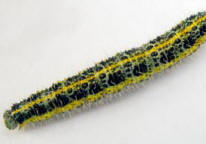 Caterpillar
CaterpillarSigns - Leaves stripped, or eaten from the outside edge inwards. May not always be easily visible as they can be well camouflaged. "Frass" may be seen, tiny black balls of excrement. More cunning and smaller types "mine" leaves between the upper and lower surfaces.
Damage - Young leaves can be eaten away and more mature plants are left with unsightly holes.
 Aphids
AphidsSigns - Usually thought of as greenfly, but can be black, yellow, pink, greyish-white and brown. About 2mm long when fully grown, roundish.
Damage - Heavy infestations can reduce the vigour of a plant and leave it vulnerable to attack by other pests and diseases. Frequently spread virus diseases as they move from one infected plant to another. Virus disease usually characterised by irregular yellow patches on the leaves which may be wrinkled but otherwise alive.
 Chafer
beetle larvae
Chafer
beetle larvaeSigns - Not specific to chafer beetle larvae and can seem in the early stages like drought or stress. Patches of affected lawn wilt and turn yellow or brown. On investigation, the grass can be lifted easily from the soil not held down by roots to any degree.
Damage - dead patches of lawn, may be made worse by animals such as birds foxes or badgers ripping up the grass to get at the larvae. Damage usually occurs during the autumn and is more common on light sandy soils where grass growth is already poor.

Insect
hotel / house
A sheltered insect house to help a range of beneficial
insects to over-winter in your garden. If they are over-wintering there,
they are in an ideal position come the spring and summer to wake up and
help to combat any pests you may have. Amongst others, good for ladybirds,
lacewings and solitary wasps which will help keep your unwanted garden visitors
down. Place in a sheltered place outdoors.
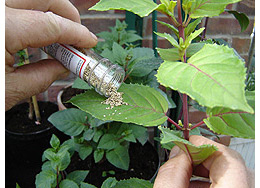
Biological
Pest Control - Organic living pest control for a variety of
problems, red spider mite, whitefly, fungus gnats (sciarid fly), thrips, mealy bug,
vine weevils and more.
These are parasites or predators that will specifically infect the pest they are brought in to control without harming any other living things and without the use of chemicals. A small population of pests needs to be maintained so that the control agent doesn't die out.

Chemical insecticides - If your plants get a heavy infestation, then I think it's acceptable to use a chemical insecticide as a "smart missile" just on that particular plant. I resort to this when the aphids build up under cover on my favourite plum tree, or other plant/s. Don't overdo it and spray too often and don't spray the whole garden "just-in-case", buy a small 1L or thereabouts sprayer so you don't get carried away.
Not pest specific.
 Leatherjackets
LeatherjacketsSigns - affected plants may turn yellow, wither and die. Small plants and seedlings may be severed at ground level. The grey - brown leatherjackets are up to 3.5cm (1 1/2inches) long, smooth, tubular and legless, rarely seen above ground, usually found just below the surface particularly in grass where a small population that causes no visible damage is more common than not.
Damage - feed on roots particularly affecting young annuals, bulbs and vegetables, predominantly affects land that has been recently brought into cultivation and usually subsides after a couple of years. On lawns, more damage is usually done by birds and small mammals digging the leatherjackets up than by the leatherjackets themselves.
 Lily
Beetle
Lily
BeetleSigns -- Cleanly cut holes in lilies and fritillaria. The easiest way to see the adults is to look upwards at the leaves by bending at the waist and turn your head upside down or lying on the ground and look up at the stems and at the bottom of the leaves. If you try to turn the leaves upside down, the beetles will drop to the ground at the slightest disturbance meaning you are less likely to find them this way. If you find one lily beetle, you can bet you've got lots more.
The larvae are very inconspicuous as they cover themselves with sticky black excreta which if you've never seen them before doesn't look anything like an insect that can devour your lovingly cared for lilies in next to no time.
The eggs are tiny, but are bright orange/red and laid in groups of up to 15, so they are surprisingly easy to see for their size - they are only laid on the underside of leaves.
Damage - leaf eaters - the years flowers can rapidly be completely destroyed before you have even seen them unfurl as small buds. They will also start on the leaves and strip them.
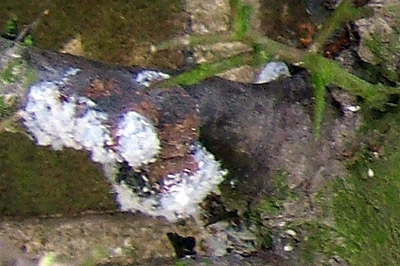 Mealybugs
MealybugsSigns - small fluffy white lumps about 5mm (1/4") appear on plants, often in the axil - where the leaf meets the stem. Leaves turn yellow and may wilt and die. Usually affect house and greenhouse plants, but also Pyracantha and fruit trees where they often are found on the wood. Sticky honeydew and black sooty moulds may accompany. Despite being insects, they don't look at all like insects, just a shapeless piece of cotton wool which is a very effective disguise and protection against all sorts of attack.
Damage - plants are rarely killed unless very heavily infested over a long period. Commonly weakened, a heavy infestation is very unsightly from the pests themselves and from the sticky honeydew that they secrete and possibly even black moulds that grow on the sticky honeydew. Root mealy bugs damage the roots.
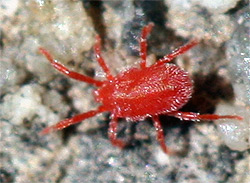 Red
spider mite
Red
spider miteSigns - Leaves become speckled, as though covered with hundreds or thousands of pale dots giving a rather ill-looking and "dusty" appearance. Heavily infested plants may become covered with fine webs. the mites themselves are less than 1mm long and not easy to see clearly.
Damage - Sap feeders which weakens the plant. Usually a problem in house and greenhouse plants as they like a dry atmosphere, can be a problem outside in hot, dry summers.
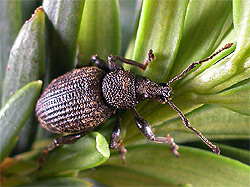 Vine
weevil adult
Vine
weevil adultSigns - Irregular notches taken from the margins of the leaves are made by the adult weevil. If a plant suddenly dies and appears to have no roots, this is the work of the larvae. The way you find out is by looking at a poorly looking plant, when you go to pick off a dead leaf, the whole lot lifts from the roots in your hand - it's a bit late by then though. Adults may be seen around plants, look for cream / white larvae in compost when re-potting plants.
Damage - Depends on the size of the root system and the number of grubs eating it. Growth will slow, the plant may then begin to wilt and finally die as it no longer has sufficient roots to sustain it. Unfortunately by the time it has been discovered it is usually to late to take steps for that plant, though others not so far gone can be protected.
 Whitefly
WhiteflySigns - Most commonly found on houseplants and in greenhouses, when disturbing the leaves, the tiny white flies that hide under the leaves will fly up.
Damage - Sap suckers, will weaken the plant and make it susceptible to further attacks of pests and disease.
Questions and Answers about pests - those not covered on the connected pages linked to above
Q. Colorado beetles - I know these are not a pest in UK (You lucky people) However, they seem to be everywhere else in Europe, and right now they are making war on my potatoes. I've traced two half decent descriptions which contradict each other in relation to the ability of these beastie to FLY. Can it fly? I've been picking them off the crop (what's left of it ) and I can see no evidence that they fly.
A. Colorado beetles are
members of the Coleoptera like other beetles. They have two
pairs of wings, the outer are hardened into elytra and are often
coloured, this is what you see when you find a beetle. In Colorado
beetles the elytra are coloured yellow with black stripes.
Under the elytra are flying wings, the usual transparent
veined wings you associate with insects, these are folded and
protected by the elytra. Beetles fly by spreading the elytra
wide to get them out of the way and then flap the flying wings
in the usual manner.
Colorado beetles are fairly weak
fliers - the reason we don't have them in the UK, they can't
manage the hop across the channel easily even helped by winds.
So, yes Colorado beetles can fly - but they don't brag
about it. They will commonly walk to the next plant they infect
rather than fly.
You have my sympathies.
Q. My greenhouse tomato
crop is being attacked by beetles. They are 3 or 4 mm
long, shiny black, with 4 yellow spots on their backs. Do you
have any idea what they are, and is there any way to control
them without making the fruit inedible?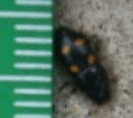
addendum - I definitely
don't think these are ladybirds (picture attached) - would
that they were! They are slimmer in shape - more the shape of
a lily beetle, though a different colour, and smaller. They
don't jump, so I don't think they are flea beetles. I thought
at first I had blossom-end rot, but it's actually holes in the
fruit, some quite large, not always at the base of the fruit,
and some of which contain the said beetles. Even some of the
green fruits are showing evidence of attack. I have looked carefully
and there is no sign of any aphid infestation at all. I would
say that the adults have laid their eggs inside the fruit and
the larvae have been eating the fruit from the inside, then
are emerging as adults. I have searched the web over the weekend
and can't find any pictures or any descriptions of garden pests
which match this. Meanwhile, I have some soft soap which I'm
going to use to try and kill the adults and hopefully break
the breeding cycle and try and save the rest of my crop!
A. Your beetles are probably
Anthocomus fasciatus - a species that belongs to a group
called Malachite Beetles. They are almost certainly not attacking
your tomatoes, they are most probably eating the things that
are attacking your tomatoes as both adults and larvae are predators.In
the absence of identifying the true pest, when your crop is
over, make sure you clean out all dead leaves and plants, I'd
burn them or take them down the tip. Likewise if the tomatoes
are in growbags - in case there are any pupae in the soil.
Q. I have an Acer palmatum. I found what I think to be scale mites on it.
I have taken them and their eggs off. the leaves are shrunken and wilting. can I do anything else to help it? its in a pot.
A. First of all, the chances are that you've missed some of the scale insects or their eggs (they're crafty little critters), so buy a systemic insecticide as any eggs will be hatching about now. I would also spray any adjacent plants too in case the infection is there too.
Secondly, you can help build up the health of the plant in general. Does it need re-potting? If it's not quite ready for this, but has been in the pot for some time, how about removing the top 2" or so of compost, taking care not to damage the roots and replacing this. I'd also give it a dose of slow acting fertiliser such as bonemeal and also a quick blast of a liquid fertiliser.
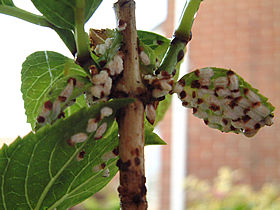 Q.
I have a Hydrangea plant that is covered in
small white 'beasties', mainly under the leaves but also
on the stems. I thought they were mealy bugs but they are more
cylindrical in shape and have a brown 'head'. They do not appear
to move. They have also destroyed a Euonymous bush and have
spread to another mature Euonymous close by. I have photo's
if that would be helpful. The leaves of the infected plants
go yellow and the plants begin to look bare and sickly. I just
want rid of them!!!
Q.
I have a Hydrangea plant that is covered in
small white 'beasties', mainly under the leaves but also
on the stems. I thought they were mealy bugs but they are more
cylindrical in shape and have a brown 'head'. They do not appear
to move. They have also destroyed a Euonymous bush and have
spread to another mature Euonymous close by. I have photo's
if that would be helpful. The leaves of the infected plants
go yellow and the plants begin to look bare and sickly. I just
want rid of them!!!
A. Blimey - horrible little beasties! These are Hydrangea scale insects. If you want to be organic, rub them off manually or cut off the stems with them on and dispose - if not too large.
The best way to get rid is to spray with a systemic insecticide that is taken up through the leaves and passed around the plant. Also spray surrounding plants and parts of the same plant that don't seem to be affected, best to spray in the evening so that bees don't encounter the pesticide.Q. Is it fair that the commercial growers can spray their crops against pests and therefore achieve a high yield of saleable produce, whereas the ordinary gardener cannot, and may suffer a considerable or even complete loss of his crop?
A. This is a question that has puzzled me too on occasion, though not many occasions and therein lies the answer possibly. What follows is "what I reckon" I haven't actually researched it. Home gardeners have been getting a lot more organic in recent years and less keen on buying sprays against pests and diseases, particularly those with the nastier chemicals.
1/ There are some chemicals available to commercial growers that are not available to the home gardener due to toxicity and appropriate use requiring regulations as to their application. Suscon Green against vine weevils is the best known of these.
2/ The main reason that many chemicals are not available easily to home gardeners is the cost of supply. Limited purchases and sometimes limited shelf life means that is just not commercially viable to produce all chemicals for the home gardener.
The commercial grower with a more expert analysis of what pests there are and purchasing much greater quantities of specialized chemicals, means that supply to this market is commercially viable. So it is not always the case that the home gardener can't get these chemicals, as in not allowed to. More that they don't use them so you end up with the chicken-and-egg with supply and demand. You may be able to get them from a horticultural wholesaler. You may find that such places require an account and/or minimum purchase of £50 / £100 - conditions that most home gardeners don't or won't meet. Don't be surprised if the smallest container costs £50 or more and holds more than the average gardener would use in a lifetime.
Picture permissions: Aphids: Lviatour - published under GNU Free Documentation License, Version 1.2 | Red spider mite: Trancelius published under Creative Commons Attribution 3.0 Unported License | Chafer larva - David Cappaert, Michigan State University, Bugwood.org, cropped - published under Creative Commons Attribution 3.0 Unported License | Leatherjacket: Rasbak - published under Creative Commons Attribution-Share Alike 3.0 Unported, 2.5 Generic, 2.0 Generic and 1.0 Generic license.
Copyright 2000 - present. All Rights Reserved | Privacy Policy Statement
